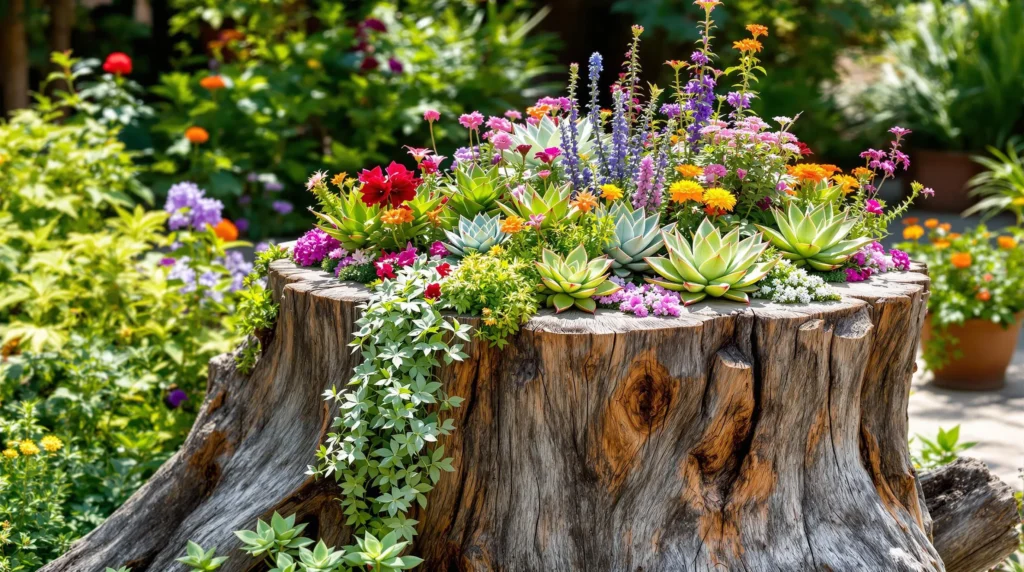10 Creative Tree Stump Planter Ideas for Your Garden
1. Succulent Garden Display
Transform your tree stump into a miniature succulent garden for a low-maintenance yet striking display. Hollow out the center of your stump about 4-6 inches deep, drill a few drainage holes, add cactus soil, and arrange various succulent varieties for different textures and colors. Succulents like Echeverias, Sedums, and Haworthias work beautifully together and require minimal watering, making them perfect for busy gardeners.
2. Cascading Flower Arrangement
Create a dramatic cascading effect by planting trailing flowers in your stump planter. Select a mix of cascading plants like petunias, lobelia, bacopa, and ivy to spill over the edges of your stump. For the best visual impact, position your stump planter in a location where the trailing plants can be fully appreciated, such as near a garden path or at the edge of a patio.
3. Fairy Garden Wonderland
Turn your tree stump into an enchanting fairy garden that will delight children and adults alike. Add miniature fairy houses, tiny furniture, small figurines, and diminutive plants like Irish moss, baby tears, and miniature ferns. Create pathways using small pebbles and incorporate tiny accessories to bring your fairy industry to life. This whimsical creation becomes a magical focal point in any garden setting.
4. Herb Spiral Planter
Convert your stump into a practical herb spiral for your cooking needs. Plant different herbs in a spiral pattern based on their water requirements – moisture-loving herbs like mint and parsley at the bottom, Mediterranean herbs like rosemary and thyme at the top. This design maximizes space and creates different microclimates within one planter, giving you fresh herbs just steps from your kitchen.
5. Bird Bath Combo Planter
Combine a planter with a bird bath for a multi-functional garden feature. Hollow out the center of your stump deeply enough to hold a shallow dish for water, then plant moisture-loving flowers around the edges. Birds will be attracted to the water while the surrounding plants add color and texture. Regular cleaning and water refreshing will keep this feature attractive to your local birds.
6. Tiered Planter System
Create a multi-level planting system using a large stump as your base. Attach smaller log sections or terracotta pots at different heights to create a tiered effect. This approach allows you to showcase multiple plant varieties and create visual interest through varying heights. Plant different colored flowers at each level for a rainbow effect, or group plants with similar care requirements together.
7. Woodland Fern Collection
Embrace the natural woodland feel by transforming your stump into a haven for shade-loving ferns. Hollow out the top, add rich, organic soil, and plant a variety of fern species like maidenhair, Japanese painted, and autumn ferns. The stump provides the perfect shaded, moist environment that ferns love, creating an authentic woodland garden feature that thrives in dappled light.
8. Living Mushroom Log
Turn your stump into a living mushroom garden for both ornamental and culinary purposes. Drill holes into the sides of the stump and insert mushroom spawn plugs of varieties like shiitake or oyster mushrooms. Keep the stump in a shaded, moist area and watch as the mushrooms begin to fruit. This living planter provides an educational opportunity and potentially delicious harvests.
9. Seasonal Bulb Display
Create a changing seasonal display by planting bulbs in your stump planter. Start with spring bulbs like tulips, daffodils, and crocuses, then swap them out for summer bloomers like dahlias and lilies as the seasons change. This rotation provides year-round interest and allows you to refresh your garden’s look without creating a new planter each season.
10. Moss and Lichen Showcase
Develop a low-profile, naturalistic planter by encouraging mosses and lichens to grow on your stump. Apply buttermilk or yogurt mixed with moss fragments to the surface of the stump and keep it moist until established. This slow-growing display creates a weathered, ancient appearance that blends perfectly with woodland or Japanese-inspired gardens while requiring almost no maintenance once established.
Transforming Hollow Stumps Into Flowering Containers
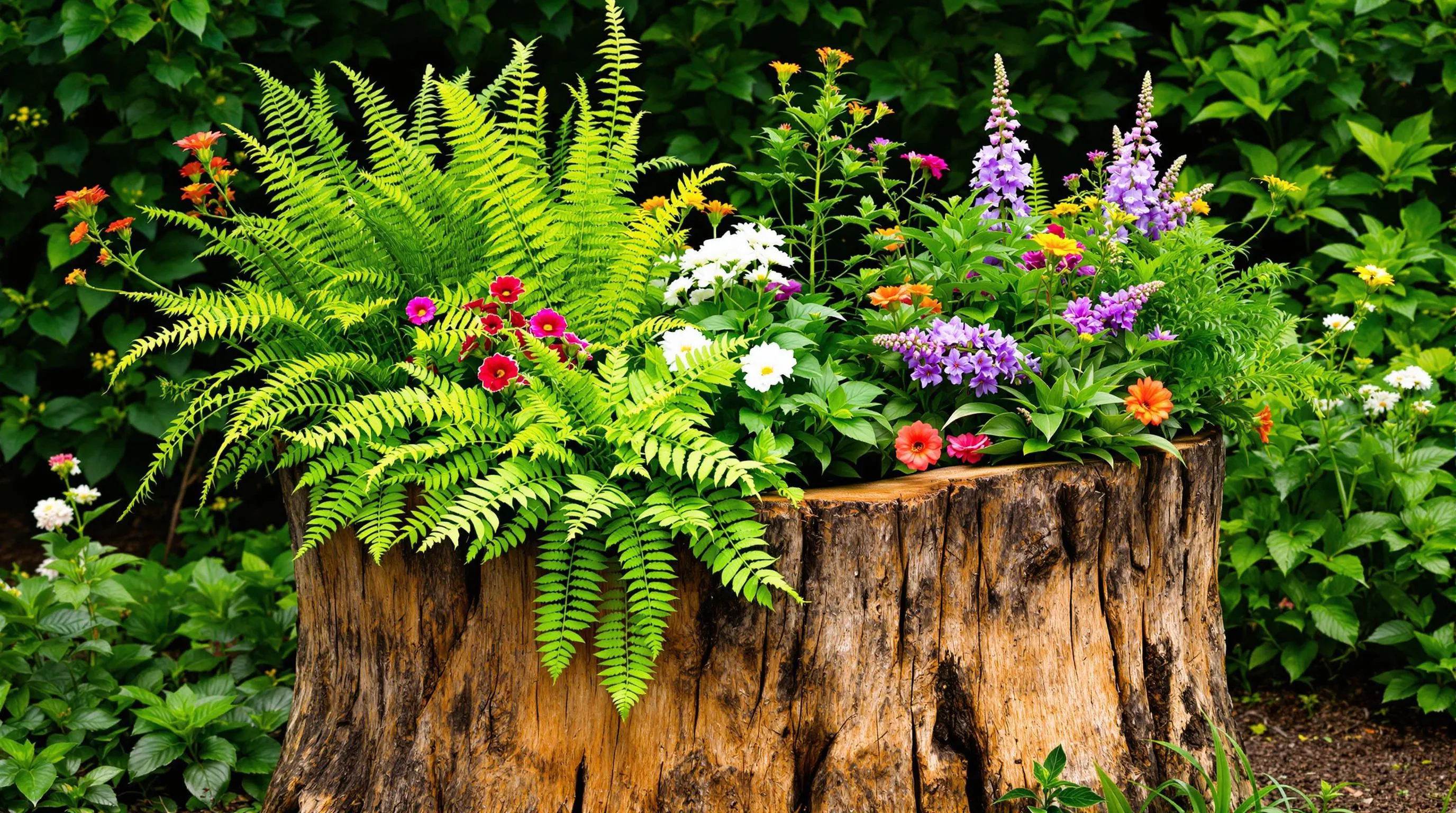
Hollow tree stumps offer the perfect natural vessels for creating stunning floral displays with minimal effort. These ready-made planters bring rustic charm to your garden while providing an ideal growing environment for many plants.
Natural Hollow Stump Planters
Natural hollow stumps present an excellent opportunity for instant planting. You’ll often find these in older stumps where decay has created a central cavity. These natural hollows already have drainage and a weathered appearance that adds character to your garden. To use a naturally hollow stump, first clear out any rotting wood, debris, or insects. Line the bottom with a layer of small rocks or gravel to ensure proper drainage, then add potting soil mixed with compost. These natural planters work beautifully with woodland plants like ferns, hostas, and native wildflowers that complement the stump’s organic aesthetic. The existing cracks and crevices in hollow stumps can also support trailing plants like ivy or creeping Jenny, creating a lush, established look.
Creating Your Own Hollow Space
If you have a solid stump, you can create your own hollow planting space with some basic tools. Start by measuring and marking a circle at least 6-8 inches in diameter on the top surface. Use a drill with a large bit to make several deep holes within your marked area, then connect these holes using a chisel and mallet. Work gradually to carve out the center, leaving walls at least 2-3 inches thick for stability. For deeper stumps, use a long drill bit or auger to extend the cavity. Once hollowed, drill several drainage holes at the bottom and sand any rough edges. To extend your stump’s lifespan, apply a non-toxic wood preservative to the outer surfaces while leaving the interior untreated. This DIY approach lets you customize the size and depth based on your planting plans while maintaining the stump’s natural appearance.
Layered Garden Displays Using Different Sized Stumps
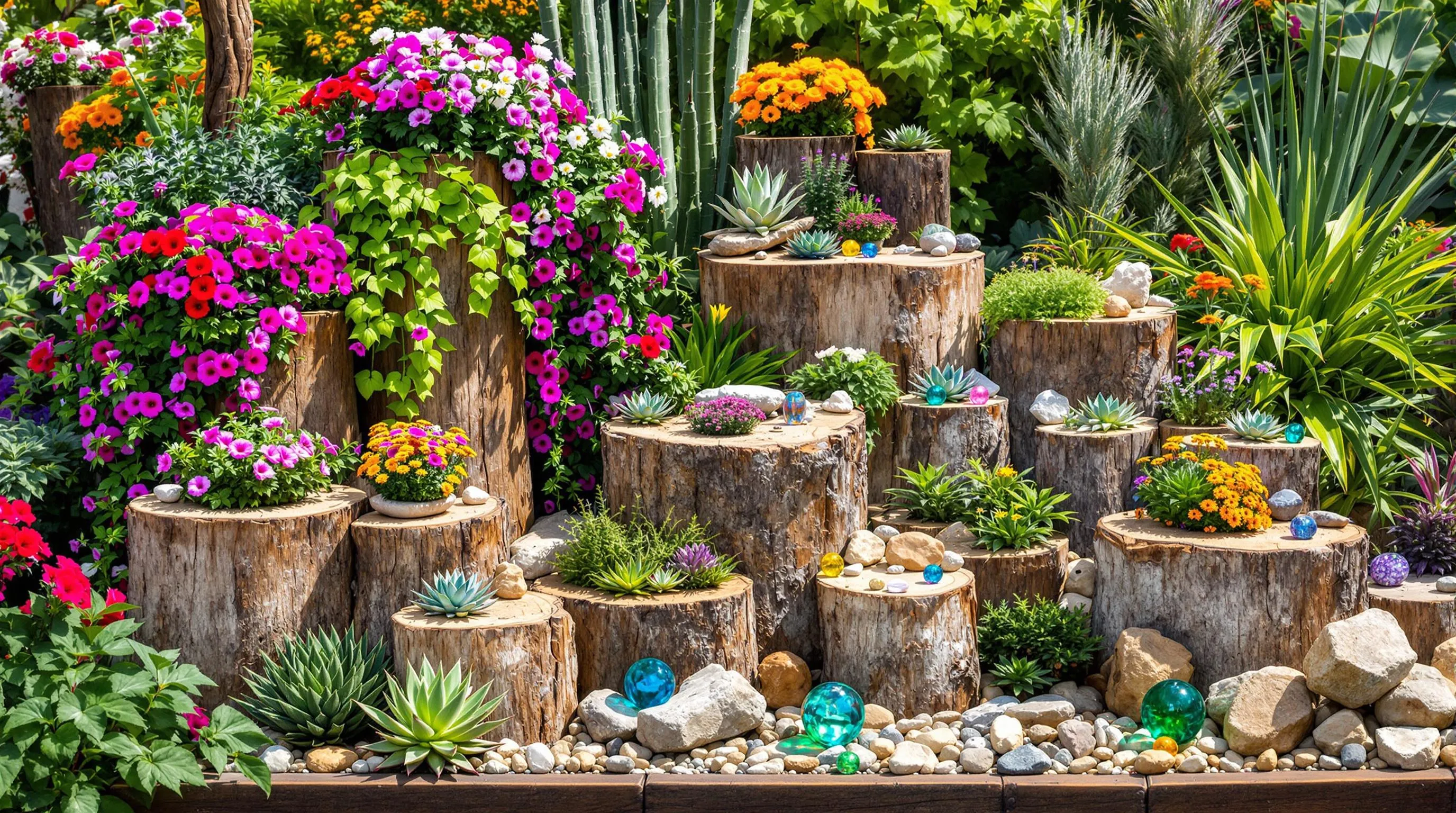
Create stunning visual interest in your garden by arranging tree stumps of various heights and diameters to form a layered display. This technique transforms multiple stumps into a cohesive garden feature that adds depth and dimension to your outdoor space.
Cascading Flower Arrangements
Transform your collection of different sized stumps into a breathtaking cascading flower display. Position larger stumps at the back or center, with medium and smaller ones arranged in front or around them. Plant cascading varieties like trailing petunias, lobelia, or creeping phlox in the higher stumps, allowing them to spill over the edges and create a waterfall effect. Fill lower stumps with compact flowering plants such as marigolds, violas, or dwarf dahlias. This strategic placement creates a natural flow of color and texture that draws the eye throughout your garden. For added impact, coordinate your flower choices with complementary or contrasting colors that bloom at different times for season-long interest.
Multi-Level Succulent Gardens
Create a striking desert-inspired display by turning your collection of stumps into a multi-level succulent garden. Arrange stumps of varying heights in a pleasing configuration, then fill each one with different succulent varieties to create a textural tapestry. Plant taller architectural succulents like Aeonium or Echeveria in larger stumps, medium-sized varieties like Haworthia or Aloe in middle-tier stumps, and small varieties like Sedum or Sempervivum in the smallest stumps. The contrasting sizes, colors, and growth habits of the succulents, combined with the different stump heights, create a fascinating miniature industry that requires minimal water and maintenance. Add small decorative rocks or colored glass between stumps to enhance the desert aesthetic and provide visual continuity.
Fairy Garden Tree Stump Planters
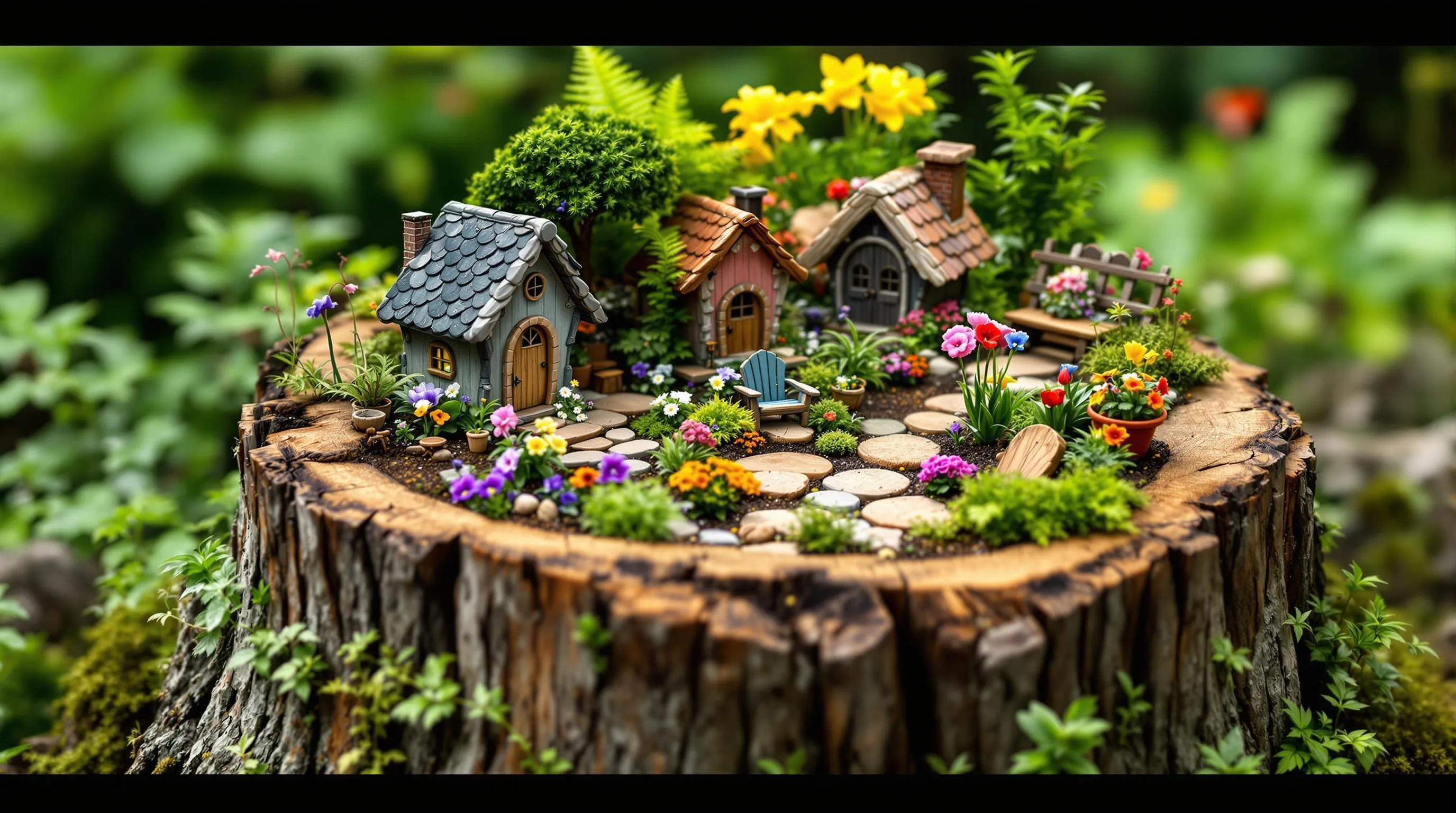
Transform your old tree stump into a magical miniature industry with fairy garden planters. These enchanting displays combine the natural beauty of stumps with whimsical elements to create a focal point that captivates visitors of all ages.
Miniature Fairy Houses and Accessories
Turn your tree stump into a fairy dwelling by adding tiny houses, doors, and windows to create the illusion of a fairy habitat. Install small fairy doors at the base of the stump, place miniature windows along the sides, or position a tiny cottage on top of the hollow. Add miniature furniture like benches, tables, and chairs to create living spaces for your imaginary residents. Incorporate small pathways made from pebbles or broken pottery pieces, leading to and from the fairy houses. Enhance the magical atmosphere with miniature accessories such as tiny lanterns, miniature fences, diminutive bridges over small ponds, and microscopic garden tools. These small details make the fairy garden come alive and tell a story within your industry.
Whimsical Plant Selections for Fairy Gardens
Choose plants that maintain the scale and whimsy of your fairy garden while thriving in your stump environment. Irish moss creates perfect miniature lawns, while baby’s tears forms lush, tiny groundcover for your fairy residents. Add dwarf varieties of traditional plants like miniature ferns, tiny hostas, and small-leaved ivies that won’t overwhelm the scene. Incorporate small flowering plants such as violas, forget-me-nots, and miniature daisies to add pops of color throughout the seasons. Creeping thyme not only looks like miniature shrubs but also releases a pleasant aroma when touched. Woolly thyme creates the appearance of tiny silvery-green cushions perfect for fairy seating areas. Select plants with interesting textures and forms that suggest trees in miniature, like dwarf Alberta spruce or small varieties of sedums that resemble tiny trees when viewed at fairy scale.
Rustic Succulent Tree Stump Arrangements
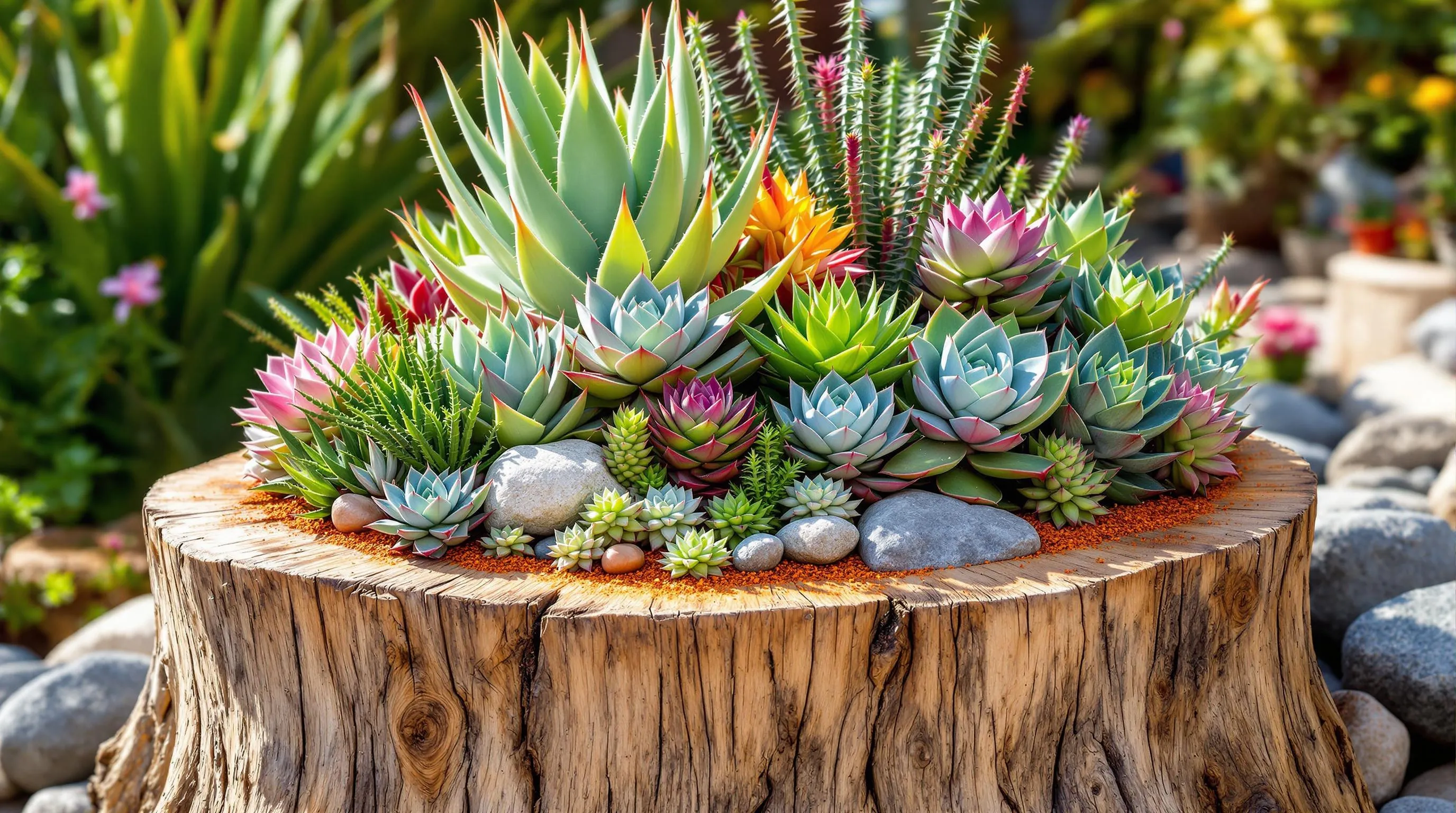
Transform your old tree stumps into stunning succulent displays that combine natural wood textures with the architectural beauty of drought-tolerant plants. These arrangements create eye-catching focal points that require minimal care while maximizing visual impact in your garden or patio.
Desert-Themed Stump Designs
Create a captivating desert oasis by arranging succulents with complementary colors and textures on your tree stump. Start with a weathered stump for an authentic desert look and plant spiky agave or aloe as your centerpiece. Surround these statement plants with smaller echeverias and sedums in varying blue-green hues. Add decorative elements like small river rocks, colored sand, or miniature desert figurines to enhance the theme. Position your desert-themed stump in a sunny location where the succulents will thrive and the dramatic shadows cast by their distinctive shapes will create additional visual interest throughout the day.
Low-Maintenance Succulent Combinations
Select a mix of hardy succulents that thrive together yet offer contrasting forms for your tree stump planter. Combine rosette-forming echeverias with trailing string of pearls or burro’s tail to create visual depth. Add height with upright pencil cacti or snake plants positioned toward the back of the arrangement. For year-round interest, incorporate succulents with seasonal color changes like sempervivums that turn reddish in cooler weather. These combinations need watering only when completely dry and require minimal pruning, making them perfect for busy gardeners. Apply a thin layer of fine gravel mulch to prevent moisture buildup around the plants’ bases and help maintain the rustic aesthetic while providing practical protection.
Incorporating Water Features Into Stump Planters
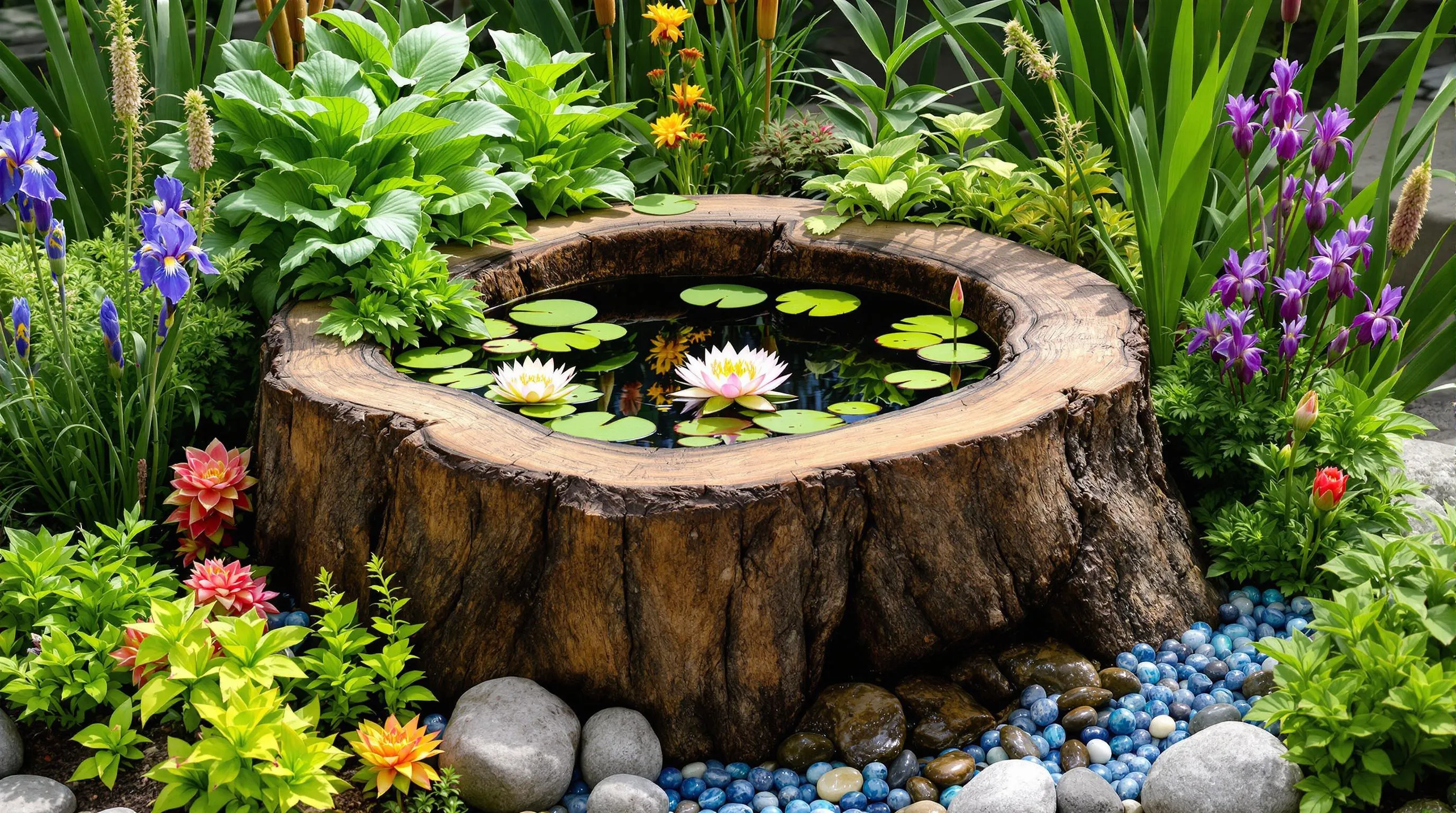
Transform your tree stump planters into serene water features that add tranquility and attract wildlife to your garden. Water elements create a ever-changing focal point while improving the natural aesthetic of your repurposed stumps.
Mini Pond Stump Gardens
Turn a larger hollow stump into a charming mini pond garden that brings aquatic elements to your industry. Start by ensuring your stump is properly sealed with pond liner or waterproof sealant to prevent leakage. Fill the cavity with water and add small floating plants like water lettuce or miniature water lilies for natural beauty. Enhance your mini pond with tiny fish such as guppies or small aquatic creatures like snails that help maintain the network. Position water-loving marginal plants around the edges—Japanese iris, miniature cattails, or water forget-me-nots create a lush border that softens the transition between wood and water. Add decorative stones or glass pebbles at the bottom to complete the aquatic display and provide hiding spots for any small creatures you introduce.
Creating a Cascading Water Feature
Design a stunning cascading water feature using multiple stump levels for a soothing water flow effect. Install a small submersible pump in the lowest stump to recirculate water up to the highest point. Hollow out channels in each stump to guide water downward in a natural-looking stream. Position moss or water-tolerant plants like creeping Jenny along the waterway to soften edges and create a lush appearance. The gentle sound of trickling water adds a meditative quality to your garden while attracting birds and beneficial insects. For evening enjoyment, incorporate small waterproof LED lights beneath the water flow to create a magical illuminated cascade when the sun goes down. This ever-changing water feature transforms ordinary stumps into an eye-catching, multi-sensory garden centerpiece that looks and sounds beautiful.
Seasonal Tree Stump Planter Displays
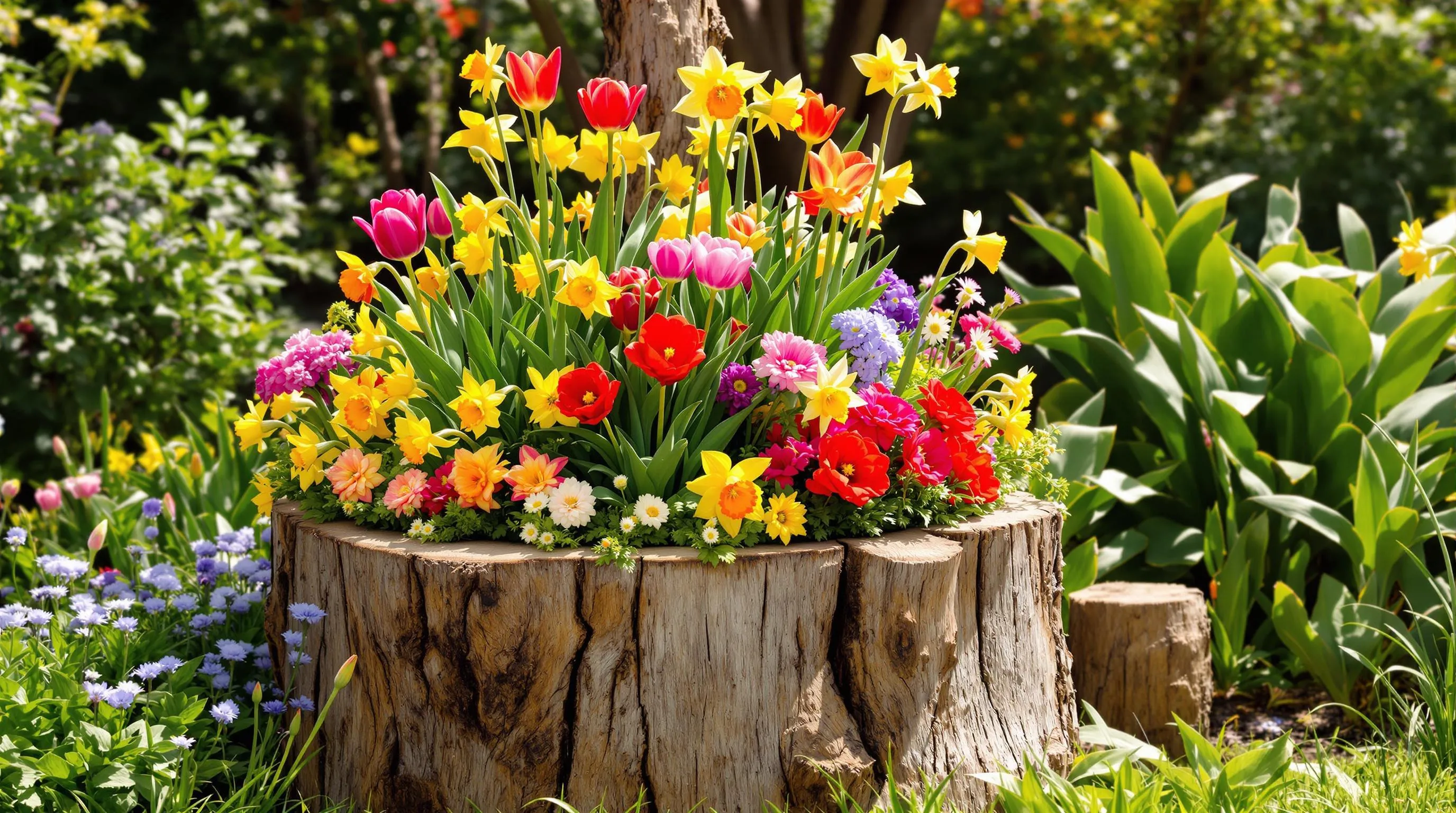
Transform your garden throughout the year with tree stump planters that celebrate each season’s unique beauty. These natural wood containers provide the perfect canvas for creating ever-changing displays that keep your outdoor space fresh and exciting.
Spring Bulb Stump Gardens
Spring bulb stump gardens burst with vibrant colors after winter’s dormancy. Plant tulips, daffodils, crocuses, and hyacinths in your hollowed stumps during fall for a spectacular spring surprise. Layer bulbs at different depths (larger ones deeper, smaller ones toward the top) to create succession blooming that lasts throughout the season. Add early-flowering perennials like primroses and forget-me-nots around the edges to complement the emerging bulbs. These stunning displays signal winter’s end while making use of your tree stumps’ natural protection, which helps shield delicate bulbs from harsh weather and provides excellent drainage.
Winter Holiday Stump Decorations
Winter holiday stump decorations transform your garden into a festive wonderland during the coldest months. Fill your stump planters with evergreen boughs, holly branches, and pinecones for a classic seasonal look. Add weather-resistant ornaments, battery-operated string lights, or even spray-painted branches in silver or gold for extra sparkle. Consider planting cold-tolerant specimens like ornamental kale, winter pansies, or dwarf conifers that thrive in cooler temperatures. For a striking nighttime display, place battery-powered candles in hurricane glasses atop your stumps, creating magical light points throughout your winter garden while showcasing the beautiful texture of the wood against the snow.
Vertical Stump Gardens With Climbing Plants
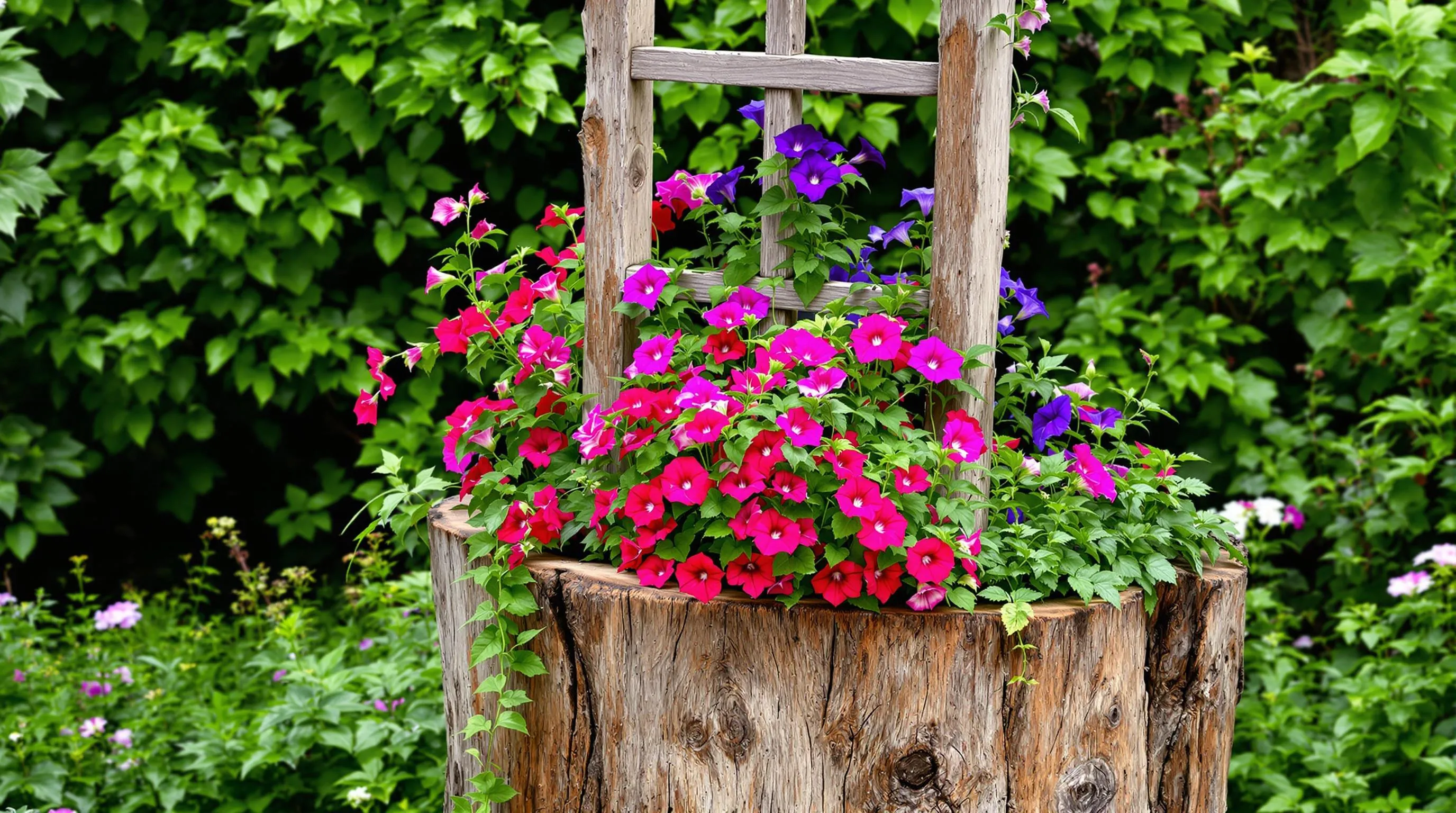
Transform your tree stump into a vertical garden by using it as a base for climbing plants. Vertical stump gardens maximize your garden space by growing upward, creating a stunning living sculpture that adds height and drama to your industry.
Trellis Additions for Climbing Vines
Adding a trellis to your tree stump planter creates the perfect support system for climbing vines and flowering plants. Install a wooden, metal, or bamboo trellis directly into the stump by drilling holes and securing it with weatherproof screws. Fan-shaped trellises work well for wider stumps, while obelisk-style supports create a dramatic vertical accent for narrower ones. For a more natural look, push several branches into the soil around the stump’s perimeter and tie them together at the top to form a teepee structure. This rustic approach complements the organic appearance of the stump while providing sturdy support for your climbing plants.
Best Climbing Plants for Stump Planters
Select climbing plants that complement your stump’s size and location for a successful vertical garden. Morning glories offer fast-growing coverage with vibrant blue, purple, or pink blooms, perfect for sunny spots. Clematis varieties provide stunning flowers in various colors and bloom times, thriving in locations with cool roots and sunny tops. For edible options, plant scarlet runner beans or cucumbers which produce harvests while covering your stump with greenery. In shaded areas, try climbing hydrangea or English ivy for reliable coverage. Jasmine and honeysuckle add intoxicating fragrance to your vertical stump garden, attracting pollinators throughout their blooming season. For year-round interest, evergreen climbers like star jasmine or certain clematis varieties maintain their foliage even in winter months, ensuring your stump garden remains attractive in all seasons.
Tree Stump Herb Gardens for Culinary Enthusiasts
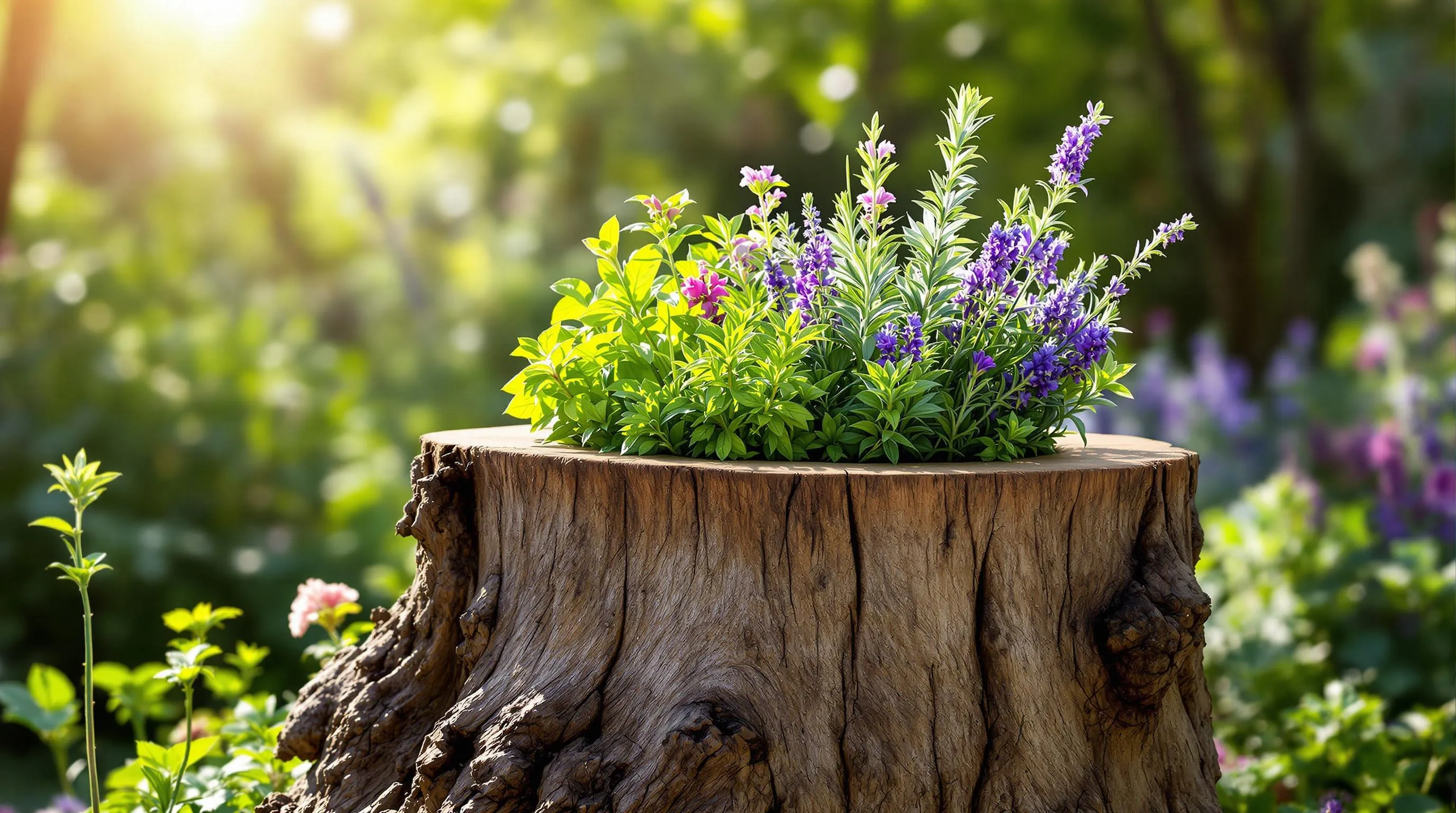
Transform your tree stump into a practical herb garden that’s both beautiful and functional. Herb gardens in tree stumps combine rustic charm with culinary convenience, creating an accessible source of fresh flavors right in your yard.
Kitchen Herb Selections for Stumps
Tree stumps make ideal containers for culinary herbs that you’ll actually use in your cooking. Choose herbs that complement each other both visually and in growing requirements. Plant Mediterranean favorites like rosemary, thyme, and oregano together in sun-drenched stumps, as they share similar drought-tolerant characteristics. For partially shaded stumps, create a collection of mint, parsley, and chives that thrive with less direct sunlight. Arrange your herbs with taller varieties like rosemary and sage toward the center or back of the stump, surrounding them with cascading herbs such as creeping thyme or trailing rosemary for dimensional interest. Add plant markers made from small branches or stones to identify each herb, making harvesting simple when you’re in the middle of cooking.
Medicinal Herb Stump Gardens
Create a dedicated medicinal herb garden in your tree stump to grow natural remedies right outside your door. Select therapeutic herbs like echinacea, chamomile, and calendula that not only offer healing properties but also attract beneficial pollinators with their flowers. Plant lavender near the edges to cascade down the sides, adding both fragrance and calming properties to your garden. Include versatile herbs like lemon balm for its stress-relieving qualities and peppermint to aid digestion. Consider adding yarrow and comfrey, traditional healing herbs that have been used for centuries to treat minor wounds and inflammation. Design your medicinal stump garden with plant height in mind—taller plants like echinacea in the center surrounded by mid-height chamomile and low-growing thyme—creating a visually pleasing arrangement while ensuring each plant receives adequate sunlight.
Preserving and Protecting Your Tree Stump Planter
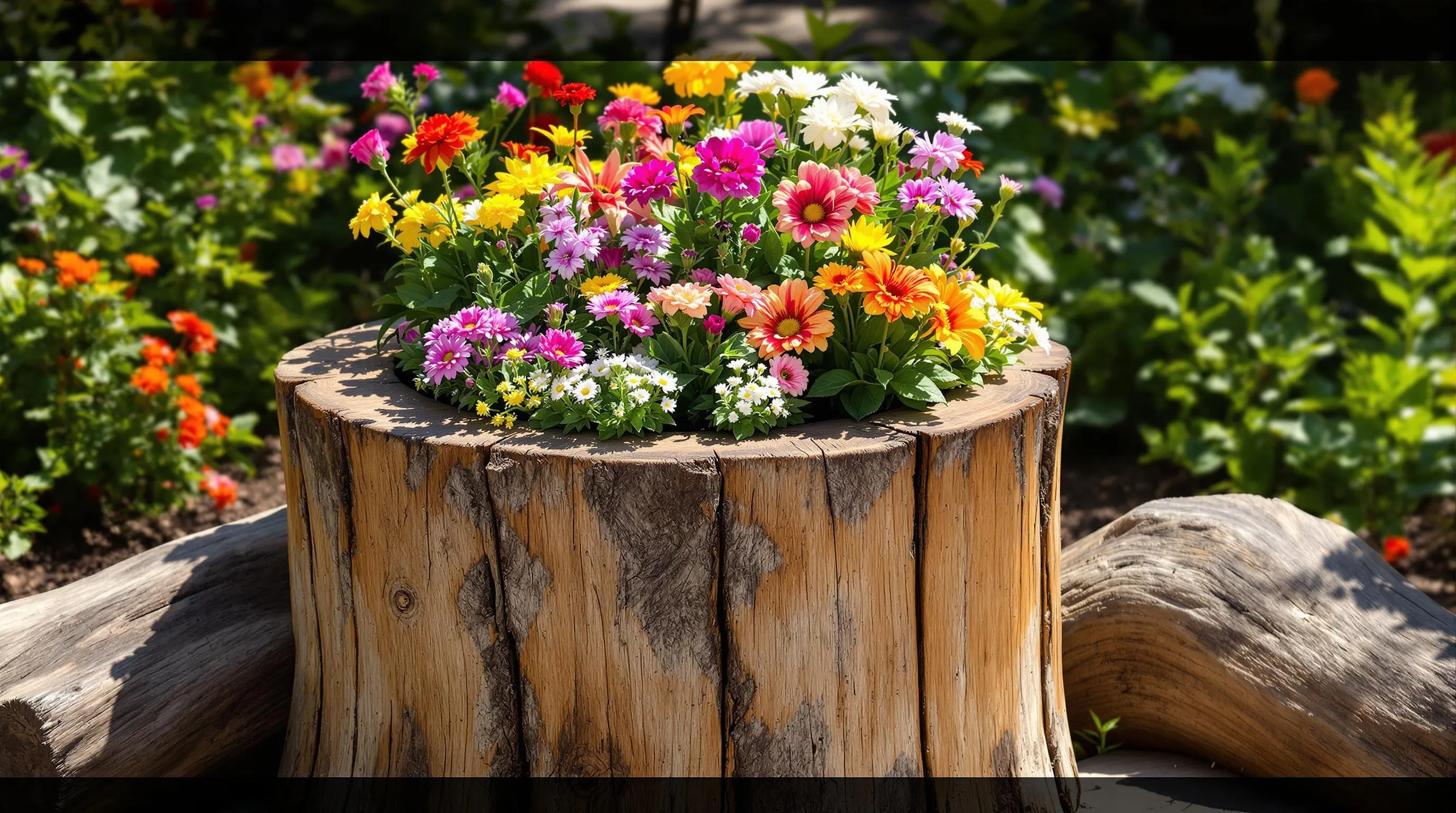
To ensure your tree stump planter remains a beautiful garden feature for years to come, proper preservation is essential. Without adequate protection, your creative stump garden could deteriorate prematurely due to natural elements and pests.
Weatherproofing Techniques
Weatherproofing your tree stump planter extends its lifespan dramatically against rain, sun, and temperature fluctuations. Start by thoroughly cleaning the stump’s surface with a stiff brush to remove loose debris. Apply a quality marine-grade sealant or exterior polyurethane to the outside surfaces, working it into cracks and crevices. For enhanced protection, use multiple thin coats rather than one thick layer. Create a slight slope on the top edges of your planter to encourage water runoff, preventing pooling that leads to deterioration. Consider adding a decorative copper cap to the top rim of your stump for both aesthetic appeal and additional weather protection, as copper naturally inhibits fungal growth.
Preventing Rot and Decay
Effective drainage is your primary defense against rot in stump planters. Drill several 1/2-inch drainage holes in the bottom of your hollowed stump, then add a 2-inch layer of gravel before adding soil. Treat the interior with a plant-safe wood preservative or food-grade mineral oil to create a moisture barrier without harming your plants. Elevate your stump planter slightly off the ground using decorative bricks or stones to prevent ground moisture absorption. Inspect your stump regularly for signs of decay, particularly after heavy rain periods. For long-term protection, apply a borate-based wood preservative annually, which effectively prevents insect infestation and fungal growth while remaining non-toxic to your plants and surrounding wildlife.
DIY Steps to Create Your Own Tree Stump Planter
Your tree stump planter journey doesn’t have to end with these ideas. By transforming garden eyesores into stunning focal points you’ve embraced sustainable gardening at its finest. Whether you’ve created a fairy wonderland a practical herb garden or a dramatic succulent display you’ve given new life to what was once considered waste.
Remember that with proper sealing and drainage your creative stump planters can last for years while providing unique character to your outdoor space. As seasons change your living sculptures will evolve bringing fresh beauty to your garden industry.
The beauty of stump planters lies in their versatility and individuality—no two are exactly alike making your garden truly one-of-a-kind. Now it’s your turn to grab some tools and transform that old stump into your next garden masterpiece!

